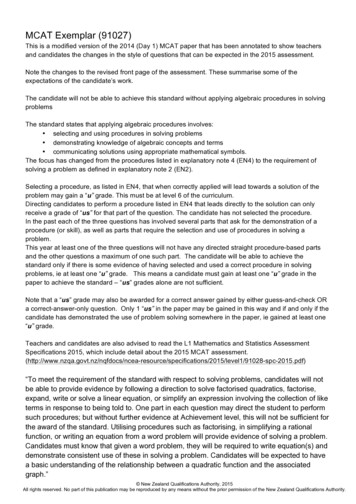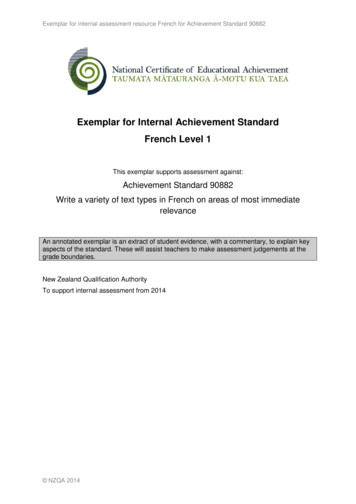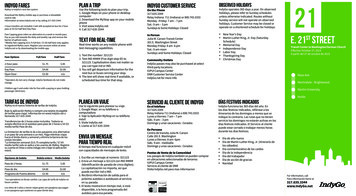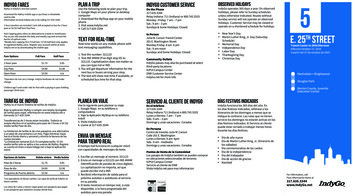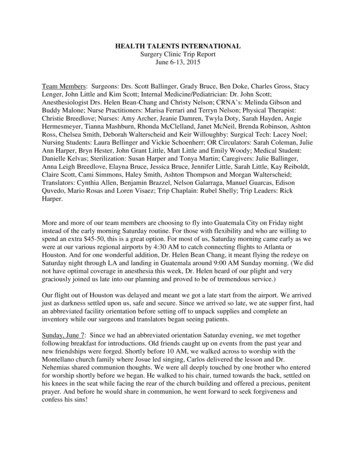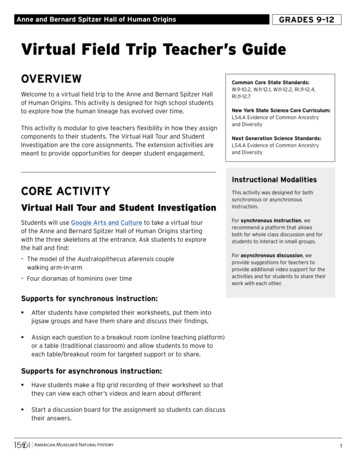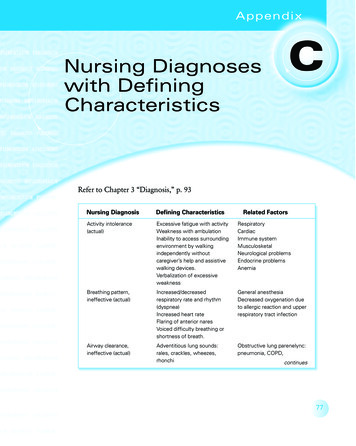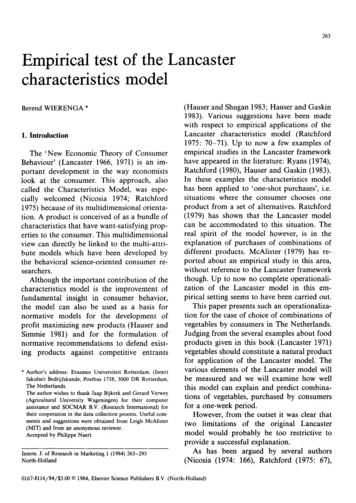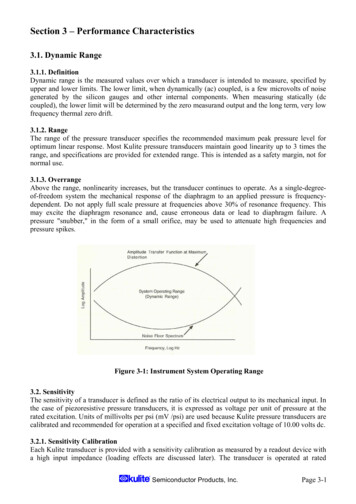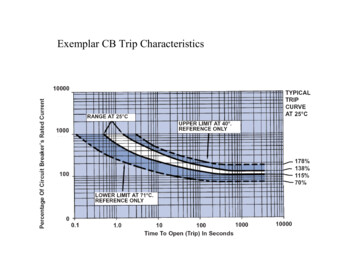
Transcription
Exemplar CB Trip Characteristics
Exemplar CB Trip Requirements
Temperature Rise Stabilized at 20 minutesTemperatureunder a tyewrap rose to260CTemperaturebetween tyewraps was227C
Damage to wire after 40 minutes @ 83AUnder Fiberglas/Silicone Sleeve
Effects of temperature coefficient of copper ontemperature rise of 10AWG wire . . .Rt 0.010 [1 .0039 (Tconductor -20) ]Tconductor RtI2(θconductor-surface)Tconductor {0.010 [1 .0039 (Tconductor -20) ] } I2 (θconductor-surface)Note that T(conductor) appears on both sides of the equationfor T(conductor) with a positive effect. This says thattemperature rise on a wire not only goes up with squareof current but gets a boost from tempco of copper. Aregenerative effect . . .
Realistic Expectations?Is the 82A test relevant to the question of safety of flight?The one-hour carry for 160% at -40C is but one of thousandsof points that describe operation of the circuit breaker.For example, suppose we load the system with a 41A, twohour soft fault. The breaker will NEVER open yet thepotential for dumping energy into the fault is the same as forthe 82A case.How does one craft a 82A, 2-hour fault?
Hard Fault Definition:Circuit Protection opens quickly ( 10 seconds).Substantial portion of energy dumped during the eventis spread over the resistive components in series withenergy source. Total energy dump measured in tens andhundreds of Killojoules.
The World of Hard Faults:50A CB Trip at 218AFault. Resistance for a “hard” fault is low and the faultdissipates only a small portion of total energy expended. Energy expended isdistributed over the various components of system source impedanceincluding the breaker itself and the faulted wire.
Soft Fault Definition:Fault condition is protracted in time - minutes to hours.Majority of energy dumped during the event isconcentrated at the fault location. Total energy dump isunbounded and measured in Megajoules.
Energy dissipation for various faultconditions . . .
How and where can we hypothesize an enduring 83A fault?What volume would it occupy?
The World of Soft Faults:In 1999, an E90 was on final to Clovis, NM when elevatorcables became “unhooked”. Landing was accomplished withpower and pitch-trim. Examination revealed that Copilot’sheated windshield feeder was inappropriately secured duringearlier maintenance. Feeder rubbed (and presumably arced)against elevator cable to the point of failure. No smokenoted. No electrical system anomalies noted. 40A breaker didnot operate.This is a good example of substantial energy being dumpedinto a very small volume over a long period of time andcausing damage hazardous to flight.
The World of Soft Faults:A DC arc welding set runs about 70VDC. Assume 200Asetting for welding heavy plate (14,000 watts). Assume 1/4”per second of bead formation or 56,000 Joules per inch ofweld.Consider the 8 MJ test conducted on the 10AWG wire:This means that energy dumped into our dial-a-fault generatorfor the 40 minute wire test would have run a 9-foot bead ofarc weld in a boilerplate joint!.
The World of Soft Faults:
The World of Soft Faults:
AC43.13-1B . . .
Excerpt from Eaton Breaker Catalog . . .
Summary of Simple-ideas surrounding fault characterization:Hard fault: Short duration Low total energy Easily mitigated by thermal devices (fuses, breakers, current limiters) Energy dissipation spread over length of source-to-fault feed path Energy density at the fault is low Potential for damage is lowSoft fault: Protracted duration High total energy Cannot be detected by thermal protective devices Energy dissipation concentrated in small volume Energy density at the fault is high Potential for damage is high
Summary of simple-ideas surrounding wire protection:Electrical: Place a current sensing device in series with the circuit to be protected. Characterize that protection and the wire so that NORMAL continuous loadsdo not place the wire’s insulation at risk when considerations are made foroperating environment. Thermal breakers only detect and mitigate hard faults. If there is risk of softfault the use of arc-detection breakers is indicated.Mechanical: Bundle wires, secure to structure to prevent flexing/chafing of bundles. Provide clearance from structure and still more clearance from fluid lines andmoving parts. Avoid exposing wire to fluid hazards (hydraulic, oil, ozone, etc).
Summary of design features for the galley cabinet wiring: Wire bundle carrying the 10AWG wires is well protected in theairplane. Robust insulation (Tefzel) is doubled up with silicone/Fiberglasoverlay. No potential for isolated and undetected exposure to moving parts orhazardous fluids. Operating environment is about as benign as it gets . . . The cabinetshares space with passengers. A hard fault to the 10AWG wire would easily open the 50A mainfeeder breaker. Hard and soft faults of the far end of the 10AWG feeder are mitigatedby an array of small (1-10A breakers) on the galley cabinet bus.
There is historical prescient in thousands of SE aircraft withrear mounted batteries where feeder to starter is 2AWG butfeeder to bus and alternator is smaller. When mechanicalprotection per Mil-W-5088 offers confidence for fault freeoperation,the bus andalternatorfeeders aredownsizedinaccordancewith largestanticipatedcontinuousload . . .
ANL City on the Bonanza Firewall . . .Bonanza doesuse an array ofANL limiters toprotect reducedwire-sizefeeders . . .
ANL current limiters are widelyused at RAC and throughoutaviation for protection of feedersincluding Bonanzas and Barons. Suppose we installed an ANL 35to “protect” the 10AWG wire inquestion . . . . Note ANL35 carries 70Aindefinitely. An ANL35 installed inobservance of the rule-of-thumbrecommendations, offers littleimprovement in the protectionphysics for soft faults. Like circuit breakers, ANLlimiters are decidedly “hard fault”protection only!
Does the 10AWG wire present a safety of flight issue?Conclusions: AC43.13-1B, Paragraph 11-48 is in error. It ignores the nature of soft faults andand cannot be complied with. The 83A wire-bundle heating experiment was interesting but not relevant to thisstudy. The 10AWG wire in question is adequately protected against soft faults by virtueof the design and installation of the galley cabinet that follows the sprit and intent ofMil-W-5088 combined with . . . The 10AWG wire in question is adequately protected against hard faults by virtueof the 50A main feeder breaker and the combination of smaller breakers on thegalley cabinet bus. The 10AWG wire is more properly considered a bus feeder than a supply line to asingle appliance. Based on points examined in the foregoing study and cited above, I believe nohazard exists and and “corrective action” would not add value to the airplane.
Mil-W-5088 combined with . . . The 10AWG wire in question is adequately protected against hard faults by virtue of the 50A main feeder breaker and the combination of
